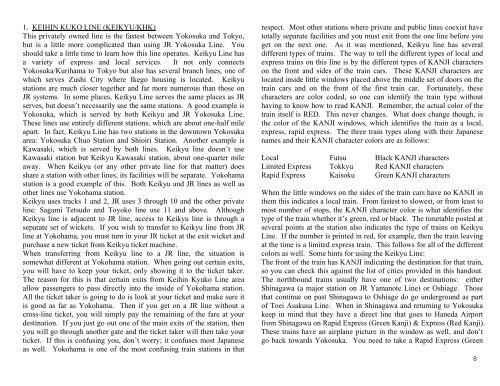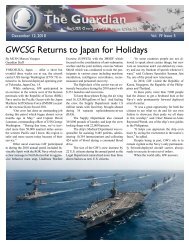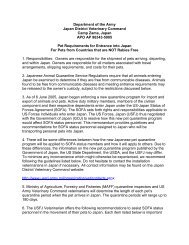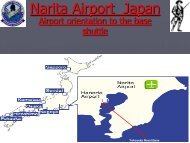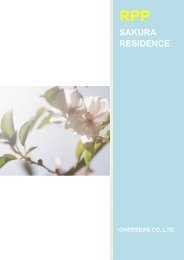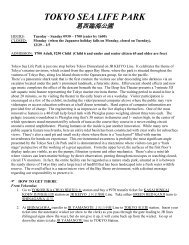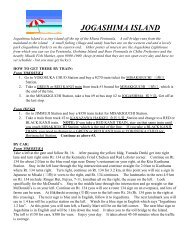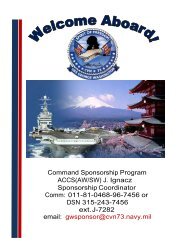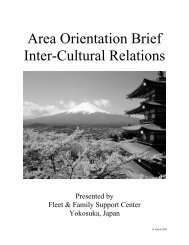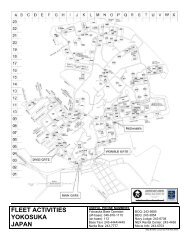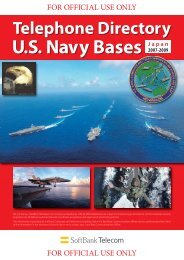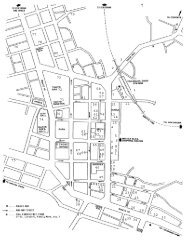TRAINS IN JAPAN
TRAINS IN JAPAN
TRAINS IN JAPAN
You also want an ePaper? Increase the reach of your titles
YUMPU automatically turns print PDFs into web optimized ePapers that Google loves.
1. KEIH<strong>IN</strong> KUKO L<strong>IN</strong>E (KEIKYU/KHK)<br />
This privately owned line is the fastest between Yokosuka and Tokyo,<br />
but is a little more complicated than using JR Yokosuka Line. You<br />
should take a little time to learn how this line operates. Keikyu Line has<br />
a variety of express and local services. It not only connects<br />
Yokosuka/Kurihama to Tokyo but also has several branch lines, one of<br />
which serves Zushi City where Ikego housing is located. Keikyu<br />
stations are much closer together and far more numerous than those on<br />
JR systems. In some places, Keikyu Line serves the same places as JR<br />
serves, but doesn’t necessarily use the same stations. A good example is<br />
Yokosuka, which is served by both Keikyu and JR Yokosuka Line.<br />
These lines use entirely different stations, which are about one-half mile<br />
apart. In fact, Keikyu Line has two stations in the downtown Yokosuka<br />
area: Yokosuka Chuo Station and Shioiri Station. Another example is<br />
Kawasaki, which is served by both lines. Keikyu line doesn’t use<br />
Kawasaki station but Keikyu Kawasaki station, about one-quarter mile<br />
away. When Keikyu (or any other private line for that matter) does<br />
share a station with other lines, its facilities will be separate. Yokohama<br />
station is a good example of this. Both Keikyu and JR lines as well as<br />
other lines use Yokohama station.<br />
Keikyu uses tracks 1 and 2, JR uses 3 through 10 and the other private<br />
line: Sagami Tetsudo and Toyoko line use 11 and above. Although<br />
Keikyu line is adjacent to JR line, access to Keikyu line is through a<br />
separate set of wickets. If you wish to transfer to Keikyu line from JR<br />
line at Yokohama, you must turn in your JR ticket at the exit wicket and<br />
purchase a new ticket from Keikyu ticket machine.<br />
When transferring from Keikyu line to a JR line, the situation is<br />
somewhat different at Yokohama station. When going out certain exits,<br />
you will have to keep your ticket, only showing it to the ticket taker.<br />
The reason for this is that certain exits from Keihin Kyuko Line area<br />
allow passengers to pass directly into the inside of Yokohama station.<br />
All the ticket taker is going to do is look at your ticket and make sure it<br />
is good as far as Yokohama. Then if you get on a JR line without a<br />
cross-line ticket, you will simply pay the remaining of the fare at your<br />
destination. If you just go out one of the main exits of the station, then<br />
you will go through another gate and the ticket taker will then take your<br />
ticket. If this is confusing you, don’t worry; it confuses most Japanese<br />
as well. Yokohama is one of the most confusing train stations in that<br />
respect. Most other stations where private and public lines coexist have<br />
totally separate facilities and you must exit from the one line before you<br />
get on the next one. As it was mentioned, Keikyu line has several<br />
different types of trains. The way to tell the different types of local and<br />
express trains on this line is by the different types of KANJI characters<br />
on the front and sides of the train cars. These KANJI characters are<br />
located inside little windows placed above the middle set of doors on the<br />
train cars and on the front of the first train car. Fortunately, these<br />
characters are color coded, so one can identify the train type without<br />
having to know how to read KANJI. Remember, the actual color of the<br />
train itself is RED. This never changes. What does change though, is<br />
the color of the KANJI windows, which identifies the train as a local,<br />
express, rapid express. The three train types along with their Japanese<br />
names and their KANJI character colors are as follows:<br />
Local Futsu Black KANJI characters<br />
Limited Express Tokkyu Red KANJI characters<br />
Rapid Express Kaisoku Green KANJI characters<br />
When the little windows on the sides of the train cars have no KANJI in<br />
them this indicates a local train. From fastest to slowest, or from least to<br />
most number of stops, the KANJI character color is what identifies the<br />
type of the train whether it’s green, red or black. The timetable posted at<br />
several points at the station also indicates the type of trains on Keikyu<br />
Line. If the number is printed in red, for example, then the train leaving<br />
at the time is a limited express train. This follows for all of the different<br />
colors as well. Some hints for using the Keikyu Line:<br />
The front of the train has KANJI indicating the destination for that train,<br />
so you can check this against the list of cities provided in this handout.<br />
The northbound trains usually have one of two destinations: either<br />
Shinagawa (a major station on JR Yamanote Line) or Oshiage. Those<br />
that continue on past Shinagawa to Oshiage do go underground as part<br />
of Toei Asakusa Line. When in Shinagawa and returning to Yokosuka<br />
keep in mind that they have a direct line that goes to Haneda Airport<br />
from Shinagawa on Rapid Express (Green Kanji) & Express (Red Kanji).<br />
These trains have an airplane picture in the window as well, and don’t<br />
go back towards Yokosuka. You need to take a Rapid Express (Green<br />
8


